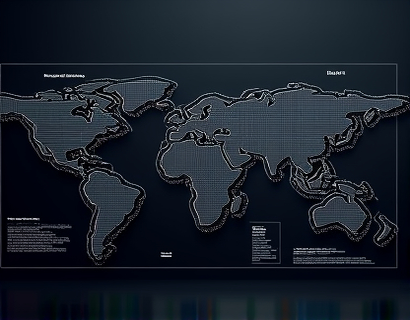Optimizing Complex Systems: Advanced Software for Graph Theory and Fluid Dynamics Research
In the realm of applied mathematics, researchers and engineers face intricate challenges when delving into graph theory and fluid dynamics. These fields, pivotal for understanding complex systems, demand sophisticated tools to manage, analyze, and visualize vast amounts of data. Recent advancements in software technology have introduced cutting-edge solutions designed to streamline data analysis and enhance visualization, thereby driving innovative discoveries and performance optimization in these complex domains.
Graph Theory Research: Navigating Complex Networks
Graph theory, a branch of mathematics that studies the properties and applications of graphs, plays a crucial role in modeling and analyzing various complex systems. These systems range from social networks and computer networks to biological systems and transportation infrastructures. The complexity of these networks often necessitates advanced computational methods to extract meaningful insights. Modern software solutions have been developed to address these needs, offering powerful algorithms and efficient data processing capabilities.
One of the primary challenges in graph theory research is the management of large-scale networks. Traditional methods often struggle with scalability and computational efficiency. Advanced software tools now provide optimized algorithms that can handle massive datasets with ease. These tools employ parallel processing techniques and distributed computing to significantly reduce computation times. For instance, graph partitioning algorithms can efficiently divide large graphs into smaller, more manageable subgraphs, facilitating parallel analysis and reducing the overall computational load.
Visualization is another critical aspect of graph theory research. Understanding the structure and dynamics of complex networks often requires intuitive visual representations. Advanced software solutions offer sophisticated visualization tools that can render graphs in various formats, including 2D and 3D representations. These visualizations help researchers identify patterns, clusters, and anomalies within the data, leading to deeper insights and more informed decision-making.
Fluid Dynamics Research: Simulating Complex Fluid Behaviors
Fluid dynamics, the study of fluids in motion, is essential for a wide range of applications, from aerospace engineering to environmental science. Simulating fluid behaviors accurately and efficiently is a significant challenge due to the nonlinear nature of fluid equations and the high dimensionality of the problems involved. Advanced software tools have revolutionized fluid dynamics research by providing robust numerical methods and high-performance computing capabilities.
Computational Fluid Dynamics (CFD) is a key area where software plays a pivotal role. CFD simulations involve solving the Navier-Stokes equations, which describe the motion of fluid substances. These equations are inherently complex and require sophisticated numerical techniques for accurate solutions. Modern CFD software incorporates advanced solvers that can handle both laminar and turbulent flows, providing high-fidelity simulations that capture the intricate details of fluid behavior.
Mesh generation is a critical step in CFD simulations. The quality of the mesh directly impacts the accuracy and efficiency of the simulation. Advanced software tools offer automatic mesh generation algorithms that can create high-quality meshes for complex geometries. These algorithms adaptively refine the mesh in regions of high gradient, ensuring that the simulation captures the essential features of the fluid flow without unnecessary computational cost.
Visualization in fluid dynamics is equally important. Understanding the flow patterns, pressure distributions, and velocity fields requires detailed visual representations. Advanced software solutions provide a range of visualization techniques, including streamline plots, contour plots, and vector fields. These visualizations help researchers identify critical flow features, such as vortices and boundary layers, which are crucial for optimizing fluid systems.
Integrated Approaches for Complex Systems Analysis
The integration of graph theory and fluid dynamics in the study of complex systems offers a comprehensive framework for understanding multifaceted phenomena. For example, in the analysis of traffic flow, graph theory can model the network of roads and intersections, while fluid dynamics can simulate the movement of vehicles as a continuous flow. Advanced software tools that support both domains enable researchers to develop integrated models that capture the interplay between network structure and fluid dynamics.
Multiphysics simulations are another area where integrated approaches shine. These simulations involve coupling multiple physical phenomena, such as fluid flow, heat transfer, and structural mechanics. Advanced software solutions provide a unified platform for performing multiphysics simulations, allowing researchers to model and analyze complex systems with greater accuracy and efficiency. The ability to simulate multiple physical processes simultaneously reduces the need for separate tools and simplifies the overall workflow.
Enhancing Research Productivity and Collaboration
The advanced software tools discussed herein not only improve the technical aspects of research but also enhance productivity and collaboration among researchers. Cloud-based platforms and collaborative tools enable multiple researchers to work on the same project in real-time, regardless of their physical location. This collaborative environment fosters knowledge sharing and accelerates the research process.
Data sharing and reproducibility are critical in scientific research. Advanced software solutions often include features for version control, data versioning, and publication-ready visualizations. These features ensure that research findings are transparent and reproducible, adhering to the highest standards of scientific integrity.
Case Studies and Real-World Applications
To illustrate the practical impact of these advanced software tools, consider a few real-world applications. In the field of traffic engineering, researchers used integrated graph and fluid dynamics models to optimize traffic signal timings and road network designs. The simulations provided valuable insights into traffic flow patterns, leading to significant reductions in congestion and travel times.
In environmental science, researchers applied multiphysics simulations to study the dispersion of pollutants in water bodies. By coupling fluid dynamics with chemical reaction models, they were able to predict the spread of contaminants and develop effective mitigation strategies. The detailed visualizations generated by the software helped in communicating the findings to policymakers and the public.
Future Directions and Emerging Trends
The field of software for graph theory and fluid dynamics research is rapidly evolving, driven by advancements in computational power, machine learning, and data science. One emerging trend is the integration of machine learning techniques to enhance the predictive capabilities of simulations. Machine learning models can be trained on simulation data to identify patterns and make predictions, reducing the need for extensive simulations and saving computational resources.
Another area of interest is the development of user-friendly interfaces that bridge the gap between complex algorithms and end-users. Intuitive graphical user interfaces (GUIs) and interactive visualization tools make advanced software more accessible to researchers who may not have a deep background in computational methods. This democratization of tools empowers a broader range of researchers to leverage these powerful technologies.
Furthermore, the increasing availability of high-performance computing resources, including cloud-based supercomputers, is enabling researchers to tackle even more complex problems. The combination of advanced software and scalable computing infrastructure opens up new possibilities for exploring uncharted territories in graph theory and fluid dynamics.
In conclusion, the advancement of software solutions for graph theory and fluid dynamics research has transformed the way scientists and engineers approach complex systems. These tools not only streamline data analysis and enhance visualization but also drive innovative discoveries and performance optimization. As the field continues to evolve, the integration of cutting-edge technologies will further enhance the capabilities of researchers, leading to breakthroughs in various scientific and engineering domains.










































